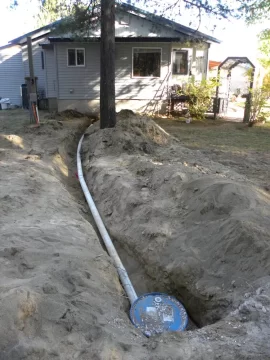Noting some pretty serious corrosion of my 12 year old concrete d-box, and just guessing how much damage it's done to my septic tank over the last 30 years, my septic tech suggested I get our water softener off the septic system. Trouble is, that system is in our basement utility room, surrounded by house or patio on three sides, with the only exit being thru a 2' thick granite wall on the fourth side.
I do have a 4" drain line that runs around most of the perimeter of the house, which I believe to be all non-perforated, it catches water off all of our downspouts and tees into a 6" line that runs to a storm drain. I could run a 2" line from outside this utility room, and tee into this line at the nearest downspout drop, about 60 feet away. It's a job, but nothing insurmountable.
But penetrating this foundation wall below grade is going to be a serious "thing". Plumbing thru the wall above grade ain't the prettiest thing, but it's hidden by some landscaping, and could be done if it doesn't create two problems:
1. Freeze potential.
2. Air gap violation.
On the air gap, I'm assuming that I'd still want some sort of air gap, preferably outside the structure, in case the line backs up with storm water. We occasionally get big rains, which by my calculations when combining all of the various roofs and patios tee'd into this line, are coming relatively close to the total line capacity. The water softener is a piss in the ocean in this net capacity, but I don't want a backed up drain to flood our basement during a tropical storm, either.
There's no windows in that portion of the basement, but I believe grade is almost plumb with the sill, or perhaps just a few inches below. There's some slope down to the next downspout drop, so I could get this line down a few feet below basement ceiling height, but again... penetrating 2 feet of granite with much more than a 1/2" line is going to be an absolute nightmare.
Thoughts?
I do have a 4" drain line that runs around most of the perimeter of the house, which I believe to be all non-perforated, it catches water off all of our downspouts and tees into a 6" line that runs to a storm drain. I could run a 2" line from outside this utility room, and tee into this line at the nearest downspout drop, about 60 feet away. It's a job, but nothing insurmountable.
But penetrating this foundation wall below grade is going to be a serious "thing". Plumbing thru the wall above grade ain't the prettiest thing, but it's hidden by some landscaping, and could be done if it doesn't create two problems:
1. Freeze potential.
2. Air gap violation.
On the air gap, I'm assuming that I'd still want some sort of air gap, preferably outside the structure, in case the line backs up with storm water. We occasionally get big rains, which by my calculations when combining all of the various roofs and patios tee'd into this line, are coming relatively close to the total line capacity. The water softener is a piss in the ocean in this net capacity, but I don't want a backed up drain to flood our basement during a tropical storm, either.
There's no windows in that portion of the basement, but I believe grade is almost plumb with the sill, or perhaps just a few inches below. There's some slope down to the next downspout drop, so I could get this line down a few feet below basement ceiling height, but again... penetrating 2 feet of granite with much more than a 1/2" line is going to be an absolute nightmare.
Thoughts?



